2014 Peugeot 508 stop start
[x] Cancel search: stop startPage 141 of 352
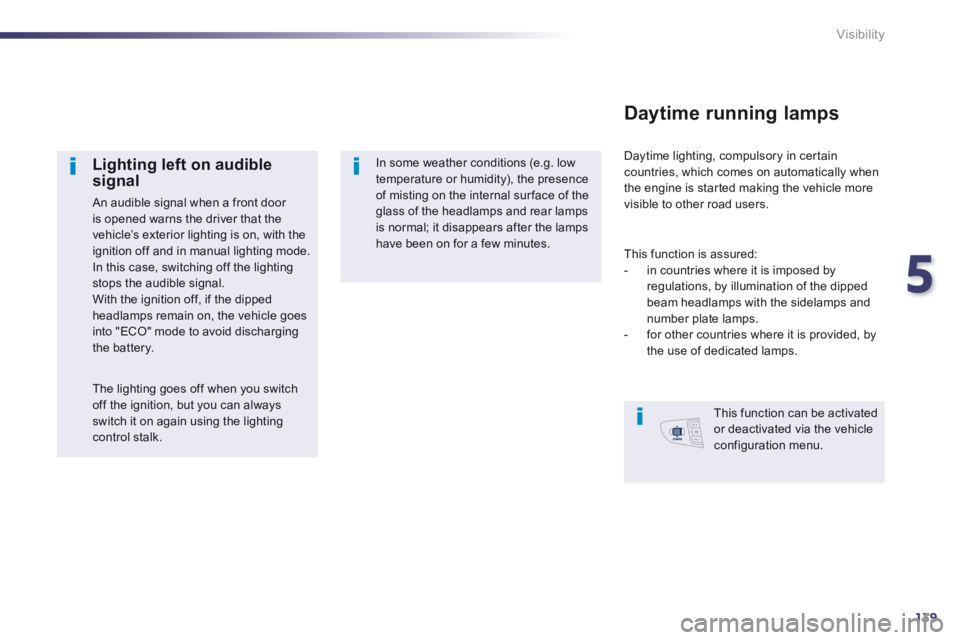
5
139
Visibility
Lighting left on audible signal
An audible signal when a front door is opened warns the driver that the vehicle’s exterior lighting is on, with the ignition off and in manual lighting mode. In this case, switching off the lighting stops the audible signal. With the ignition off, if the dipped headlamps remain on, the vehicle goes into "ECO" mode to avoid discharging the battery.
In some weather conditions (e.g. low temperature or humidity), the presence of misting on the internal sur face of the glass of the headlamps and rear lamps is normal; it disappears after the lamps have been on for a few minutes.
Daytime lighting, compulsory in certain countries, which comes on automatically when the engine is started making the vehicle more visible to other road users.
Daytime running lamps
This function is assured: - in countries where it is imposed by regulations, by illumination of the dipped beam headlamps with the sidelamps and number plate lamps. - for other countries where it is provided, by the use of dedicated lamps.
This function can be activated or deactivated via the vehicle configuration menu.
The lighting goes off when you switch off the ignition, but you can always switch it on again using the lighting control stalk.
Page 207 of 352
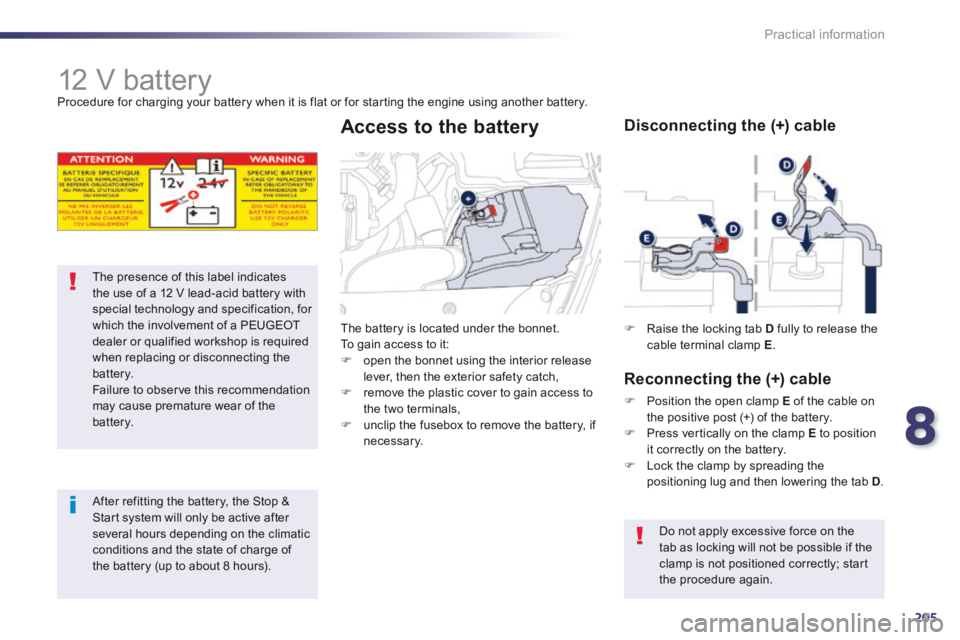
8
205
Practical information
12 V battery Procedure for charging your battery when it is flat or for starting the engine using another battery.
The presence of this label indicates the use of a 12 V lead-acid battery with special technology and specification, for which the involvement of a PEUGEOT dealer or qualified workshop is required when replacing or disconnecting the battery. Failure to observe this recommendation may cause premature wear of the battery.
After refitting the battery, the Stop & Start system will only be active after several hours depending on the climatic conditions and the state of charge of the battery (up to about 8 hours).
The battery is located under the bonnet. To gain access to it: open the bonnet using the interior release lever, then the exterior safety catch, remove the plastic cover to gain access to the two terminals, unclip the fusebox to remove the battery, if
necessary.
Access to the battery
Raise the locking tab D fully to release the cable terminal clamp E .
Disconnecting the (+) cable
Reconnecting the (+) cable
Position the open clamp E of the cable on the positive post (+) of the battery.
Press vertically on the clamp E to position it correctly on the battery. Lock the clamp by spreading the positioning lug and then lowering the tab D .
Do not apply excessive force on the tab as locking will not be possible if the clamp is not positioned correctly; start the procedure again.
Page 208 of 352
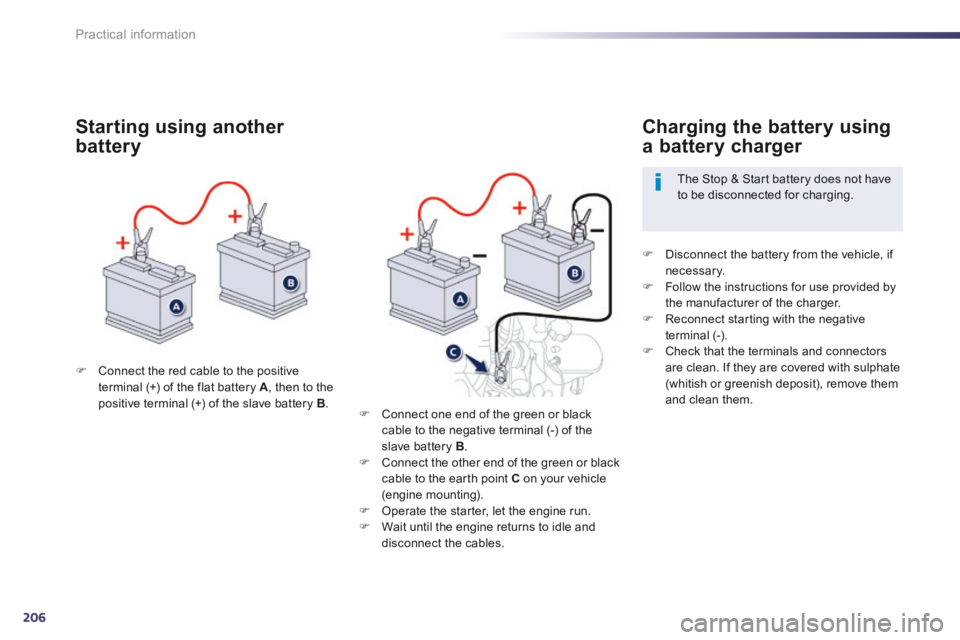
206
Practical information
Connect the red cable to the positive terminal (+) of the flat battery A , then to the positive terminal (+) of the slave battery B .
Starting using another
battery
Disconnect the battery from the vehicle, if necessary. Follow the instructions for use provided by the manufacturer of the charger. Reconnect starting with the negative terminal (-). Check that the terminals and connectors are clean. If they are covered with sulphate (whitish or greenish deposit), remove them and clean them.
Charging the battery using
a battery charger
The Stop & Start battery does not have to be disconnected for charging.
Connect one end of the green or black cable to the negative terminal (-) of the slave battery B . Connect the other end of the green or black cable to the earth point C on your vehicle (engine mounting). Operate the starter, let the engine run. Wait until the engine returns to idle and disconnect the cables.
Page 210 of 352
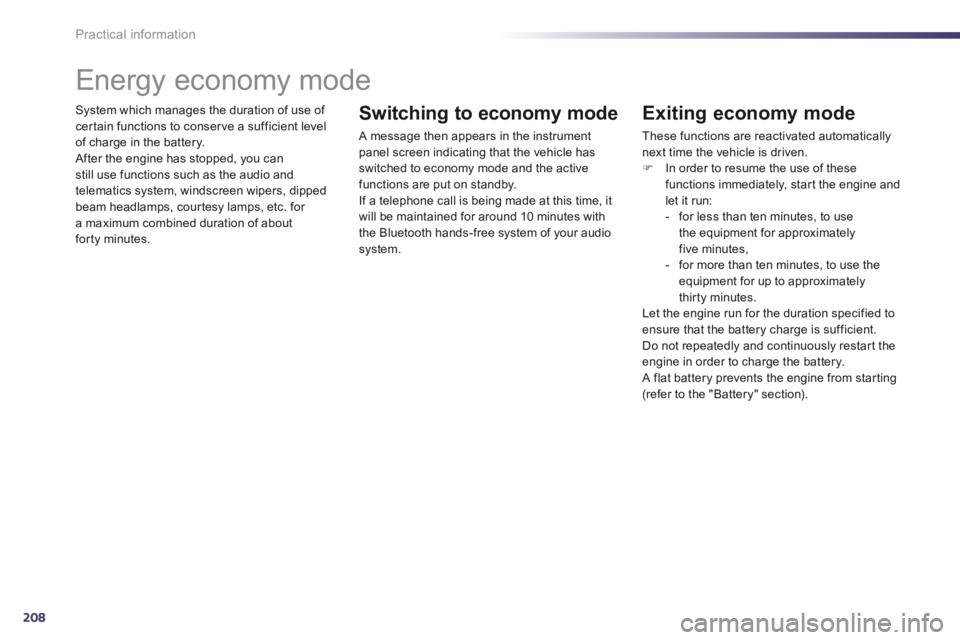
208Practical information
System which manages the duration of use of certain functions to conserve a sufficient level of charge in the battery. After the engine has stopped, you can still use functions such as the audio and telematics system, windscreen wipers, dipped beam headlamps, courtesy lamps, etc. for a maximum combined duration of about forty minutes.
Energy economy mode
Switching to economy mode
A message then appears in the instrument panel screen indicating that the vehicle has switched to economy mode and the active functions are put on standby. If a telephone call is being made at this time, it
will be maintained for around 10 minutes with the Bluetooth hands-free system of your audio system.
Exiting economy mode
These functions are reactivated automatically next time the vehicle is driven. In order to resume the use of these functions immediately, start the engine and let it run: - for less than ten minutes, to use the equipment for approximately five minutes, - for more than ten minutes, to use the equipment for up to approximately thirty minutes. Let the engine run for the duration specified to ensure that the battery charge is sufficient. Do not repeatedly and continuously restart the engine in order to charge the battery. A flat battery prevents the engine from starting (refer to the "Battery" section).
Page 220 of 352
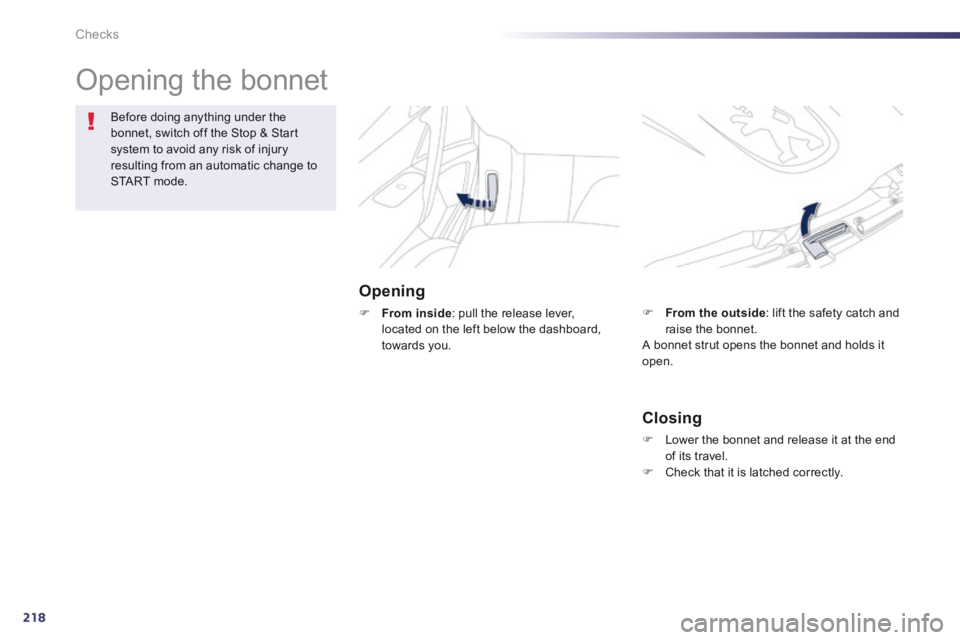
218
Checks
Opening the bonnet
Opening
From inside : pull the release lever, located on the left below the dashboard, towards you.
Before doing anything under the bonnet, switch off the Stop & Start system to avoid any risk of injury resulting from an automatic change to START mode.
Closing
Lower the bonnet and release it at the end of its travel. Check that it is latched correctly.
From the outside : lift the safety catch and raise the bonnet. A bonnet strut opens the bonnet and holds it open.
Page 230 of 352
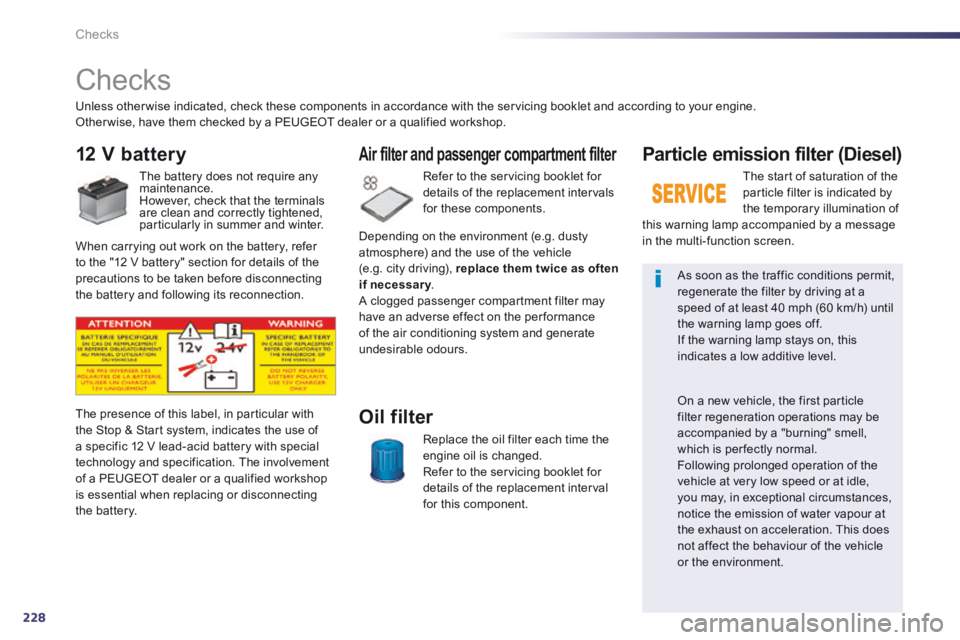
228
Checks
Checks
12 V battery
The battery does not require any maintenance. However, check that the terminals are clean and correctly tightened, particularly in summer and winter.
Refer to the servicing booklet for details of the replacement intervals for these components.
Air filter and passenger compartment filter
Replace the oil filter each time the engine oil is changed. Refer to the servicing booklet for details of the replacement interval for this component.
Oil filter The presence of this label, in particular with the Stop & Start system, indicates the use of a specific 12 V lead-acid battery with special technology and specification. The involvement of a PEUGEOT dealer or a qualified workshop is essential when replacing or disconnecting the battery.
Particle emission filter (Diesel)
The start of saturation of the particle filter is indicated by the temporary illumination of this warning lamp accompanied by a message in the multi-function screen.
As soon as the traffic conditions permit, regenerate the filter by driving at a speed of at least 40 mph (60 km/h) until the warning lamp goes off. If the warning lamp stays on, this indicates a low additive level.
On a new vehicle, the first particle filter regeneration operations may be accompanied by a "burning" smell, which is per fectly normal. Following prolonged operation of the vehicle at very low speed or at idle, you may, in exceptional circumstances, notice the emission of water vapour at the exhaust on acceleration. This does not affect the behaviour of the vehicle or the environment.
Unless otherwise indicated, check these components in accordance with the servicing booklet and according to your engine. Other wise, have them checked by a PEUGEOT dealer or a qualified workshop.
When carrying out work on the battery, refer to the "12 V battery" section for details of the precautions to be taken before disconnecting the battery and following its reconnection.
Depending on the environment (e.g. dusty atmosphere) and the use of the vehicle (e.g. city driving), replace them twice as often if necessary . if necessary . if necessary A clogged passenger compartment filter may have an adverse effect on the per formance of the air conditioning system and generate undesirable odours.
Page 236 of 352
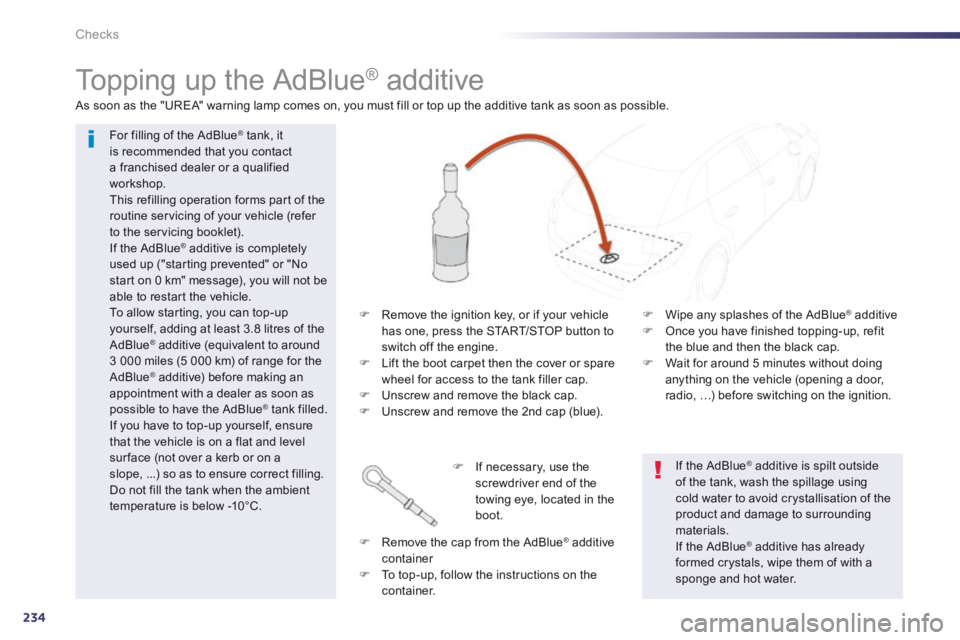
234
Checks
Topping up the AdBlue ® additive
For filling of the AdBlue ® tank, it ® tank, it ®
is recommended that you contact a franchised dealer or a qualified workshop. This refilling operation forms part of the routine servicing of your vehicle (refer to the servicing booklet). If the AdBlue ® additive is completely ® additive is completely ®
used up ("starting prevented" or "No start on 0 km" message), you will not be able to restart the vehicle. To allow starting, you can top-up yourself, adding at least 3.8 litres of the AdBlue ® additive (equivalent to around ® additive (equivalent to around ®
3 000 miles (5 000 km) of range for the AdBlue ® additive) before making an ® additive) before making an ®
appointment with a dealer as soon as possible to have the AdBlue ® tank filled. ® tank filled. ®
If you have to top-up yourself, ensure that the vehicle is on a flat and level sur face (not over a kerb or on a slope, ...) so as to ensure correct filling. Do not fill the tank when the ambient temperature is below -10°C.
As soon as the "UREA" warning lamp comes on, you must fill or top up the additive tank as soon as possible.
Remove the ignition key, or if your vehicle has one, press the START/STOP button to switch off the engine. Lift the boot carpet then the cover or spare wheel for access to the tank filler cap. Unscrew and remove the black cap. Unscrew and remove the 2nd cap (blue).
If necessary, use the screwdriver end of the towing eye, located in the boot.
Remove the cap from the AdBlue ® additive ® additive ®
container To top-up, follow the instructions on the
c o n t a i n e r.
If the AdBlue ® additive is spilt outside ® additive is spilt outside ®
of the tank, wash the spillage using cold water to avoid crystallisation of the product and damage to surrounding materials.
If the AdBlue ® additive has already ® additive has already ®
formed crystals, wipe them of with a sponge and hot water.
Wipe any splashes of the AdBlue ® additive ® additive ®
Once you have finished topping-up, refit the blue and then the black cap. Wait for around 5 minutes without doing anything on the vehicle (opening a door, radio, …) before switching on the ignition.
Page 337 of 352
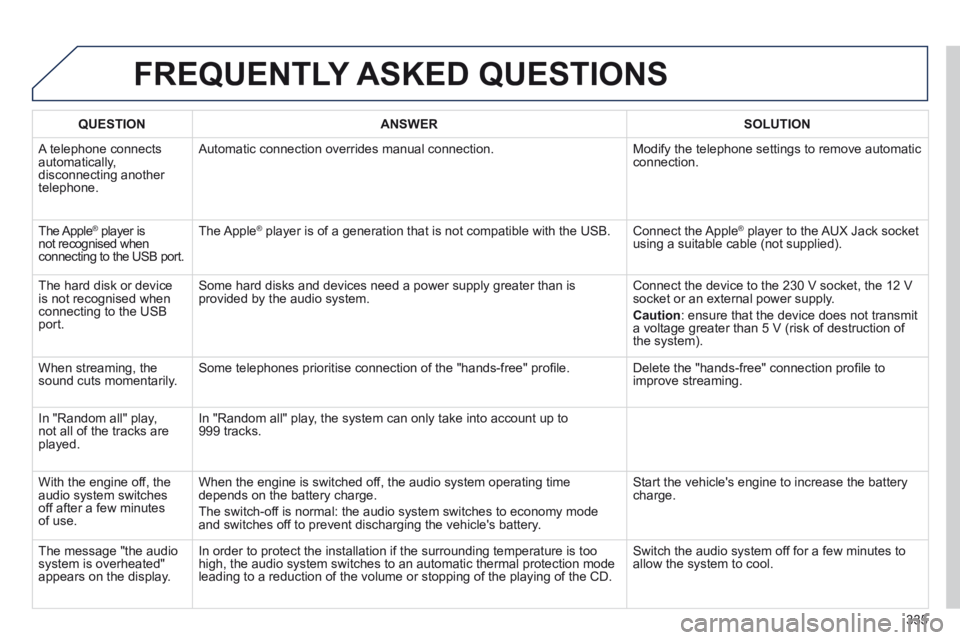
335
FREQUENTLY ASKED QUESTIONS
QUESTIONANSWERSOLUTION
A telephone connects automatically, disconnecting another telephone.
Automatic connection overrides manual connection. Modify the telephone settings to remove automatic connection.
The Apple ® player is ® player is ®
not recognised when connecting to the USB port.
The Apple ® player is of a generation that is not compatible with the USB. ® player is of a generation that is not compatible with the USB. ® Connect the Apple ® player to the AUX Jack socket ® player to the AUX Jack socket ®
using a suitable cable (not supplied).
The hard disk or device is not recognised when connecting to the USB port.
Some hard disks and devices need a power supply greater than is provided by the audio system. Connect the device to the 230 V socket, the 12 V socket or an external power supply.
Caution : ensure that the device does not transmit a voltage greater than 5 V (risk of destruction of the system).
When streaming, the sound cuts momentarily. Some telephones prioritise connection of the "hands-free" profi le. Delete the "hands-free" connection profi le to improve streaming.
In "Random all" play, not all of the tracks are played.
In "Random all" play, the system can only take into account up to 999 tracks.
With the engine off, the audio system switches off after a few minutes of use.
When the engine is switched off, the audio system operating time depends on the battery charge.
The switch-off is normal: the audio system switches to economy mode and switches off to prevent discharging the vehicle's battery.
Start the vehicle's engine to increase the battery charge.
The message "the audio system is overheated" appears on the display.
In order to protect the installation if the surrounding temperature is t\
oo high, the audio system switches to an automatic thermal protection mode \
leading to a reduction of the volume or stopping of the playing of the C\
D.
Switch the audio system off for a few minutes to allow the system to cool.